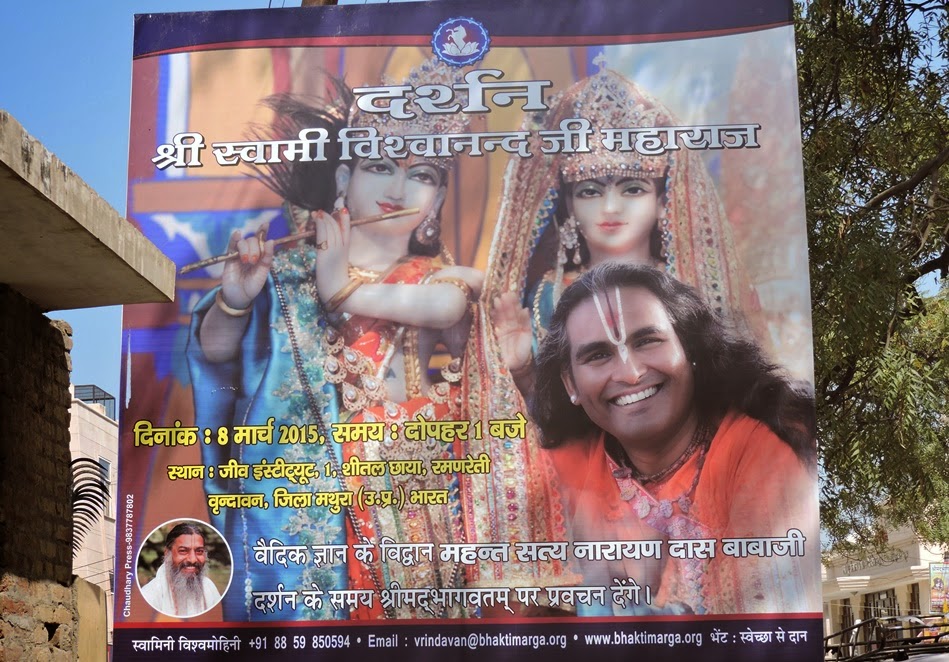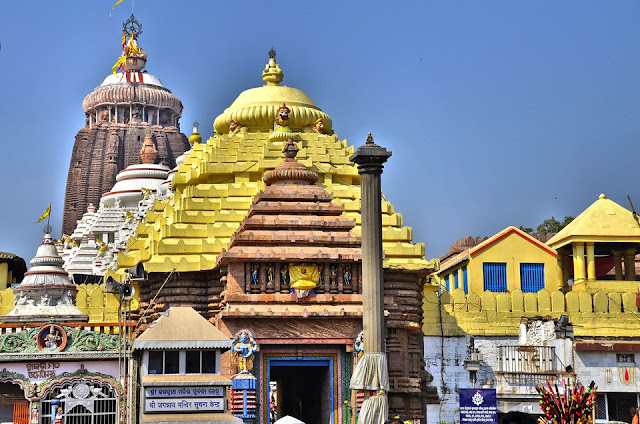DKK Nandi (1): Part I, Kila-kinchita
antaḥ-smeratayojjvalā jala-kaṇa-vyākīrṇa-pakṣmāṅkurā
kiñcit pāṭalitāñcalā rasikatotsiktā puraḥ kuñcatī
ruddhāyāḥ pathi mādhavena madhura-vyābhugna-tārottarā
rādhāyāḥ kilakiñcita-stavakinī dṛṣṭiḥ śriyaṁ vaḥ kriyāt
Radha’s eyes are a kilakiñcita bouquet of flowers:
brightened by a repressed smile,
with teardrops clinging like dew to the base of her eyelash petals;
reddened slightly around the edges;
overflowing with juices of amusement,
or contracting like buds.
Ah, such are Radha’s eyes,
made more beautiful by their flashing sweet pupils
as she is blocked on the path by Madhava,
May they bring you all good fortune.
________________________________________
This is the first of the two nāndī verses. It contains elements both of the āśīrvāda or benediction and the vastu-nirdeśa indication of the subject matter to follow in the play itself.
Āśīrvāda
Blessings in this form are quite common in poetry related to the gods and are often found in the invocations of secular texts. They use the śārdūla-vikrīḍita meter of 19 syllables to a line, describing an incident from the mythology of that particular deity, and conclude with a particular benedictory formula, such as pātu vaḥ (“May he save you”).
Large numbers of such invocatory verses can be found in the great classical compendia like Subhāṣita-ratna-kośa , Sad-ukti-karṇāmṛta or Padyāvalī. Indeed, much of what we know about attitudes or knowledge of Radha and Krishna from the pre-Gīta-govinda period comes from verses of this type and not from complete works. In the lilas related to Krishna, these verses show both a kind of playful description of the lila as well as recognition of its having a “magical force,” such as, "May Krishna’s smile deliver you, may the effulgence from his body grant you all benedictions."
The blessings in this verse are interpreted somewhat differently by each of the commentators. The word stavakinī is generally translated as a bouquet of flowers (gucchaka), but Vishwanath Chakravarti takes it to mean a flowering vine, and since it is deemed capable of giving blessings, (śriyaṁ vaḥ kriyāt) it can be deduced that it is a wish-fulfilling vine or kalpa-vallī.
What is that bouquet of flowers? It is Radharani's eyes, the mirror of her soul, which simultaneously manifest a variety of emotions that are likened to the individual flowers in the arrangement. What are these emotions? They are the different competing feelings that arise in her when Krishna surprises her on the path, blocks her way and insists on flirting with her.
Vishwanath rounds out the metaphor by explaining that the inner or partially repressed smile ( antaḥ-smerā ) means that some of these flowers are only partially blossomed, in other words she cannot openly respond to Krishna in a favorable way, drops of water are a sign that the flowers are filled with nectar, they are both red and white, the flowers are slightly bent on their stems, etc.
What benediction is being given by Radha’s eyes, so filled with mixed emotions? It is śrī, here translated as “all good fortune.” Surendranath Shastri glosses śrī simply as sampatti, or prosperity, while Vishnudasa calls it the treasure of the supreme goal (paramārtha-sampattiM). The anonymous commentator of the Dāna-keli-kaumudī (usually attributed to Vishwanath) glosses it as prema-sampatti, the treasure of divine love, while Vishwanath, in his comment on the verse in Ujjvala-nīlamaṇi, defines it as the beauty of ecstasies (sattvikas) that arise from divine love (premottha-stambha-kampādi-śobhā). This last interpretations gets some confirmation in the verses that follow in the play's prastāvanā, or introductory scene, where the devotee audience is described as reacting to hearing these verses with precisely such ecstatic reactions.
The Vaishnava sees the benediction being one of the supreme goal or the “fifth goal” of human life, which is prema. What we should note here from the very beginning is that this benediction is not coming from Krishna, nor even specifically from Radha as a powerful deity, but from her love, which is manifested in the form of this flurry of conflicting emotions.
This is an immediate sign that the DKK is distinct from Chandidas's SKK. Of course we don't have the SKK's introductory or concluding verses, but we would expect some recurring benedictory themes emanating to the audience, or even blessings at the beginning or end of the chapters. That is not there. Devakinandan concludes each verse with some blessing that will come from hearing the lila, but the source of such blessings is never designated as Radha, much less to her emotions. In fact, for Devakinandan, it is clear that he sees Narayan as the supreme divinity, and it is to him that he offers his prayers and obeisances.
It would appear then, both from this verse and the next, that Donna Wulff's statement, quoted previously on this blog, has been verified: “The absolute for Rupa is not a metaphysical principle, but an emotion... Radha, as love embodied, is thus the supreme avenue of religious realization.” ("Radha: Consort and Conqueror of Krishna" in Devi: Goddesses of India (eds. J.S. Hawley and Donna W. Wulff. Berkeley: University of California Press, 1996. p.123).
In terms of vastu-nirdeśa, then, the point of the Dāna-keli-kaumudī is not as much the līlā itself, the blocking of Radha on the path to Govinda Kund, but the divine moment, the snapshot of Radha experiencing this particular moment of blissful turmoil.
Kilakiñcita
The word kilakiñcita, or kilikiñcita is really untranslatable, and its etymological origins are also, as far as I know, unfathomed. It is a longstanding element of the dramatic art, or Nātya-śāstra. It is generally included in the descriptions of the anubhāvas or external expressions of emotion, and specifically in that subgroup knowns as alaṅkāras or ornaments. These are not to be confused with the literary ornaments, also known as alaṅkāras, but are physical manifestations that reveal specific inner emotions, which are called vyabhicāris or sañcāris. Nearly all descriptions of vyabhicārīs in the rasa-śāstra are accompanied by a list of corresponding anubhāvas.
The idea is that Radha’s beauty is enhanced by the combination of various emotions, which arise in specific circumstances.
Bharata Muni, as with most things related to this area, is not only the first to name this particular alaṅkāra, but also the first to define it:
garva-duḥkha-śramābhilāṣāṇām |
saṅkara-karaṇaṁ harṣād
asakṛt kilikiñcitaṁ jneyam ||
Kilikiñcita may be known as repeated hysterical commngling of the feelings like smiling, weeping, laughter, fear, joy, pride, sorrow, fatigue and desire. (22.18 or 24.17 depending on the edition)After Bharata, the particular combination of emotions was treated roughly in the same way by most in the Sanskrit dramatic tradition, only slight differences of view appearing:
- Agni-purāṇa (5.4) seems to pinpoint the essence of kilakiñcita as a mixture of laughing and crying, etc. (hasita-kranditādīnāṁ saṅkaraḥ kilakiñcitam).
- Daśarūpaka highlights four elements -- anger, tears, excitement and fear -- but leaves it open-ended for the possibility of more emotions to join in the mix. (krodhāśru-harṣa-bhītyādeḥ saṅkaraḥ kila-kiñcitam 2.39)
- Rasārṇava-sudhākara also has four: lamentation, anger, tears, excitement: (śoka-roṣāśru-harṣādeḥ saṅkaraḥ kilakiñcitam, 1.353),
- Sāhitya-darpaṇa mentions six: “The combination of smiling, dry tears, laughing, trepidation, anger and fatigue is called kilakiñcita .” (smita-śuṣka-rudita-hasita-trāsa-krodha-śramādīnāṁ sāṅkaryaṁ kila-kiñcitam; SD 3.117).
saṅkarī-karaṇaṁ harṣād ucyate kilakiñcitam
When pride, desire, tears, smiling, envy, fear and anger come together as a result of some joyous excitement (harṣa), that is called kilakiñcita. (UN 11.44)One feature that is found only in Bharata and Rupa Goswami is the pinpointing of a specific cause for kilakiñcita, namely harṣa or sudden excitement, which in many of the other definitions is simply given as one of the elements. Harṣa is itself one of the vyabhicārī bhāvas:
harṣaḥ syād iha romāñcaḥ svedo'śru mukha-phullatā
āvegonmāda-jaḍatās tathā mohādayo'pi ca
The pleasure of mind that comes from attaining or seeing the desired object is called harṣa. It is characterized by bristling of the body hair, perspiration, tears, a shining face, hurry or haste, intoxication, immobility, bewilderment, etc. (BRS 2.4.148)Historically, the word probably has its origins in the manifestation of excitement that is the standing of hairs (hṛṣṭa-roma, roma-harṣa) and there is a definite hint of a sexual element in this excitation rather than the kind of serene happiness implied here by the word prasannatā.
As stated in the verse under discussion, this excited joy is one that comes of suddenly encountering Krishna in an unexpected situation, where there is a component of surprise. This can come from more than just seeing Krishna, as Rupa's first example in Ujjvala-nīlamaṇi 11.45 indicates, where Krishna actually touches Radha’s breasts.
balān nyaste rādhā-kuca-mukulayoḥ pāṇi-kamale
udañcad-bhrū-bhedaṁ sa-pulakam avaṣṭambhi valitaṁ
smarāmy antas tasyāḥ smita-rudita-kānta-dyuti mukham
When I forcefully placed my lotus hands on Radha's nipples in the plain sight of her sakhis, she felt joy and excitement arising; she raised her brows, her body hairs stood on end, she gave me a crooked glance and then looked away. Ah, I remember her face at this moment, bright with both smiles and tears. (UN 11.45)The word ullāsa here should be considered synonymous with harṣa. Krishna's sudden aggressive touching of Radha is the source of her mixed emotions.
Krishnadas Kaviraj, while allowing that harṣa is a causal factor, also identifies it as a separate, eighth characteristic of kilakiñcita (as indeed seen in Bharata's definition). Since his explanation seems to be the most complete, let us just quote it here in its entirety:
When Krishna sees all these ecstatic ornaments (the various alaṅkāras) appear on Radha’s body, the ocean of his joy rises like the tide. Now listen to the description of kilakiñcita, for with this particular ornament, Radha steals Krishna’s mind. When Krishna sees Radha and wants to touch her, such as when he blocks her on the path near the Dāna-ghāṭī or when she is coming to pick flowers, and Krishna wants to put his hand on her in front of the other sakhis, these are occasions when Radha manifests kilakiñcita.Krishnadas Kaviraj quotes two verses as examples here, one being the nāndī from DKK currently under discussion, and another from his own Govinda-līlāmṛta, where he again takes pains to say that Krishna’s delight in simply drinking in Radha’s beauty at this time exceeds the pleasure of sexual union.
Its primary symptom is harṣa, which is the causal sañcāri-bhāva. Then to this are added the seven other characteristics, which follow naturally. The combining of all eight symptoms results in a mahā-bhāva. Pride, desire, tears, smiling, envy, fear and anger; each of these eight relishable moods come together at the same time, which when Krishna enjoys to his great satisfaction. It is just like the mixture of yogurt, sugar, ghee, honey, pepper, camphor and cardamom, which together make a delicious sherbet drink.
When Krishna sees Radha’s face and eyes filled with all these emotions, he gets millions of times more pleasure than he does from even sexual union. (CC 2.14.169-179)
helollāsa-calādharaṁ kuṭilita-bhrū-yugmam udyat-smitam
rādhāyāḥ kilakiñcitāñcitam asau vīkṣyānanaṁ sangamād
ānandaṁ tam avāpa koṭi-guṇitaṁ yo’bhūn na gīr-gocaraḥ
Radha’s darting eyes are anxiety-ridden, tear-filled, and red with anger. Her lips tremble owing to the pressure of Eros, her eyebrows arch and a delicate smile reveals her heart’s intention. The joy Krishna relishes on seeing her display of kilakiñcita is beyond the power of words to describe, a million times greater than that which comes from his directly making love to her. (GLA 9.18, CC 2.14.181)Krishnadas has another verse in Govinda-līlāmṛta where he specifically describes Radha’s eyes in this kilakiñcita manifestation. Radha’s eyes are the focus of the DKK verse, and it is the eyes, the windows of the soul, that reveal the emotions as they clash and swirl through Radha’s mind.
dhāvantī tṛṣitālinīva kuṭila-prāntā nivṛttā tataḥ
kiñcid bāṣpa-kulākulā’ruṇatayā spṛṣṭāñcalollāsinī
rādhā-dṛṣṭir amajjayat priyam apārānanda-vārāṁ nidhau
As Krishna touches the corner of her garment, the dancing pupils of Radha’s eyes reveal deep disdain. But still she smiles, and her eyes, like hungry bumblebees, soar on their crooked course towards Krishna’s lotus face, where their flight ends. Tears surface and those eyes turn angry red, all of which throw the Dear One into an ocean of incomparable bliss. (GLA 9.42)It should be pointed out here that this idea that the various dalliances that surround the erotic relationship, from the flirtations to the lovers' spats, the separations and even intrigues and infidelities are all considered by Rupa Goswami to be indispensible to the rasa, unlike the Vrindavan schools that are adamant that the nitya-vihāra, which dispenses with almost all of this as extrinsic or even inimical to the pure erotic mood. This has to stand out as one of the unique characteristics of the Gaudiya approach. (See UN 9.41 and 15.253)
We can give one more example from Rupa Goswami's Utkalikā-vallarī, which is taken from the point of view of the manjari, the devotee servant who wishes to observe another pastime in which the kilakiñcita symptoms arise. There Rupa Goswami prays,
jitvā pātum athotsukena hariṇā kaṇṭhe dhṛtāyāḥ puraḥ
īṣac-choṇima-mīlitākṣam anṛju-bhrū-valli-helonnataM
prekṣiṣye tava sa-smitaṁ sa-ruditaṁ tad devi vaktraṁ kadā
When will I see your face, O Devi, both laughing and crying at the same time during the time of spraying colors on one another, when Krishna has made a bet with your kiss as the wager. When he wins the bet and tries to enthusiastically take hold of your neck, in anger your eyes half close and redden and in scorn, the vine of your eyebrows bends and lifts on one side. (UV 44)
The summary is: Kilakiñcita is the confusion of emotions, of conflicting distress and elation primarily felt in the context of the purva-raga, when Krishna first gives her aggressive and not altogether welcome attention. It is a situation where theretofore she has been fantasizing about Krishna, desiring and imagining a relation with him, but has remained confined to thought and feeling. When Krishna does bursts in on her, it is a clash of reality and fantasy and she is faced with the choice of following through on her fantasy or the dictates of her internalized sense of religious duty and social obligation. Since the fantasy is closer to her true desire, so her basic reaction is one of pleasure, but the various external restraints make it necessary for her to refuse his attentions. Other elements can also be detected--flirtatiousness, for one.
If we can remark a development in the three versions of the Radha-Krishna story we are looking at, SKK, GPVJ and DKK, we can observe a progression in Radha's complicity with Krishna. For Chandidas, Radha is genuinely unwilling to surrender to Krishna at first and she only warms to him gradually. In DKK, what is stressed is Radha's love for Krishna as an eternal given.




Comments